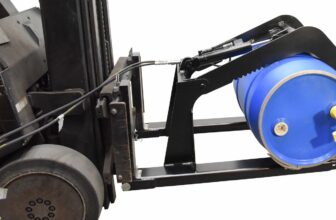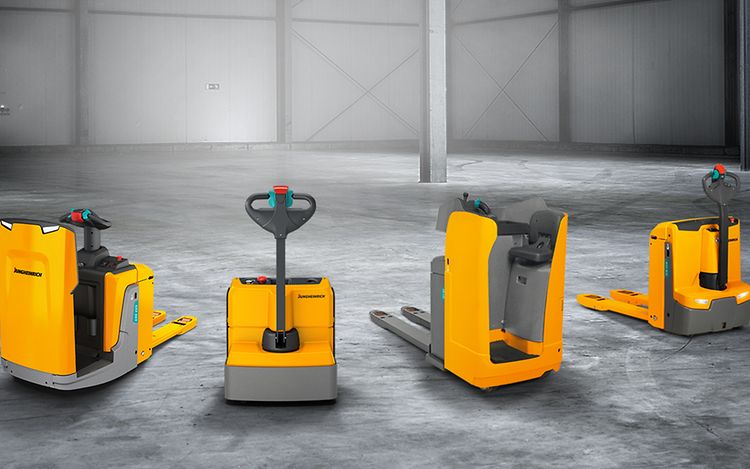
Stand up forklifts, also known as standing forklifts, are versatile and efficient industrial vehicles widely used in warehouses, distribution centers, and manufacturing facilities. With their unique design and ergonomic features, these forklifts offer enhanced maneuverability, visibility, and productivity. In this comprehensive guide, we will delve into the various aspects of stand up forklifts, exploring their types, features, benefits, applications, safety considerations, and more.
Understanding Stand Up Forklifts
What is a Stand Up Forklift?
A stand up forklift, is a type of material handling equipment designed to lift, move, and stack loads in various industrial settings. Unlike sit down forklifts where the operator sits, standup forklifts provide an ergonomic standing platform for the operator. This design allows for improved visibility, agility, and quick entry and exit, making them suitable for tasks that require frequent stops and starts.
Types of Stand Up Forklifts
Stand up forklifts come in different configurations to cater to specific operational requirements. The main types include:

- Stand Up Counterbalance Forklifts: These forklifts feature a counterbalance design, eliminating the need for rearward counterweight. They are commonly used for general material handling tasks and can operate in both indoor and outdoor environments.
- Stand Up Reach Forklifts: These forklifts are designed for narrow aisle operations. They have extended reach capabilities, enabling them to access and retrieve loads from high racking systems. Stand up reach forklifts are ideal for warehouses with limited space and high-density storage needs.
- Stand Up Order Picker Forklifts: Order picker forklifts are used primarily in order picking operations where operators need to access items at various levels. These forklifts allow operators to elevate themselves to reach items on shelves, making them suitable for efficient order fulfillment.
Key Components of Stand Up Forklifts
Stand up forklifts consist of several essential components that contribute to their operation and functionality. Some of the key components include:
- Mast: The mast is the vertical assembly that houses the lifting mechanism of the forklift. It consists of inner and outer uprights and hydraulic cylinders, allowing the forklift to raise and lower the load.
- Forks: Forks are the arms that extend from the front of the forklift and support the load. They come in various lengths and configurations to accommodate different load sizes and shapes.
- Power Source: Stand up forklifts can be powered by various sources, including electric batteries or internal combustion engines. Electric forklifts offer cleaner and quieter operation, while internal combustion forklifts provide greater power and are suitable for outdoor applications.
- Controls and Instrumentation: The operator controls the movement and operation of the forklift using a combination of controls, such as levers, pedals, and buttons. Instrumentation includes gauges and displays that provide essential information about the forklift’s status.
Benefits of Stand Up Forklifts
Enhanced Maneuverability
Stand up forklifts are designed for exceptional maneuverability, allowing operators to navigate tight spaces with ease. The compact size and agile nature of these forklifts make them ideal for operating in narrow aisles and confined areas, maximizing storage capacity and optimizing workflow efficiency.
Improved Visibility
The standing position in stand up forklifts offers better visibility for the operator compared to sit down forklifts. With an unobstructed view of the surroundings, operators can navigate more safely and efficiently, reducing the risk of accidents and collisions.
Increased Productivity
Stand up forklifts enable quick entry and exit, eliminating the time wasted on getting in and out of a seated position. This feature is particularly beneficial for tasks that involve frequent stops and starts, resulting in improved productivity and reduced operator fatigue.
Space Efficiency
Stand up forklifts excel in space utilization, especially in warehouses with narrow aisles. Their compact design allows for tighter turning radii, enabling efficient maneuvering in confined spaces. By utilizing the available space more effectively, stand up forklifts contribute to maximizing storage capacity.
Versatile Applications
Stand up forklifts find application in a wide range of industries and material handling operations. From loading and unloading trucks to order picking and stacking pallets, these forklifts offer versatility and adaptability to meet diverse operational requirements.
Applications of Stand Up Forklifts
Stand up forklifts are utilized across various industries and applications due to their versatility and maneuverability. Some common applications include:
- Warehousing and Distribution: Stand up forklifts play a vital role in warehouse operations, where they are used for tasks such as loading and unloading trucks, moving pallets within the warehouse, and stacking inventory on high shelves. Their ability to navigate narrow aisles and confined spaces makes them ideal for efficient material handling in busy distribution centers.
- Manufacturing Facilities: Stand up forklifts are employed in manufacturing facilities for transporting raw materials, components, and finished products. They are essential in production lines where quick and efficient movement of materials is crucial for maintaining smooth operations.
- Retail and E-commerce: In the retail sector, stand up forklifts are utilized in distribution centers and fulfillment centers to handle inventory, replenish stock, and fulfill customer orders. With their maneuverability and agility, these forklifts contribute to speedy order processing and efficient inventory management.
- Wholesale and Logistics: Stand up forklifts are commonly used in wholesale operations and logistics centers for handling goods, loading and unloading containers, and organizing inventory. Their versatility allows for seamless integration into various stages of the supply chain.
Safety Considerations for Standing Forklift Operation
Operating stand up forklifts safely is of paramount importance to prevent accidents and ensure the well-being of operators and those working in the vicinity. Here are some essential safety considerations:
Operator Training and Certification
Proper operator training and certification are crucial for safe standind forklift operation. Operators should undergo comprehensive training programs that cover aspects such as equipment operation, load handling techniques, safety protocols, and hazard awareness. Certification ensures that operators have the necessary skills and knowledge to operate the forklifts safely. Reference: Visit Forklift Operator Training Requirements.” Occupational Safety and Health Administration (OSHA) for more details.
Pre-Operation Inspection and Maintenance
Regular inspection and maintenance of stand up forklifts are essential to identify any potential issues or malfunctions. Operators should conduct pre-operation inspections, checking for any visible damage, worn-out components, or leaks. Any identified issues should be reported and addressed promptly by trained maintenance personnel.
Load Handling and Stability
Proper load handling is critical for maintaining stability and preventing accidents. Operators should ensure that loads are properly secured, evenly distributed, and within the forklift’s weight capacity limits. Overloading can compromise stability and increase the risk of tip-overs.
Operating Environment
Operators must be aware of their operating environment and adhere to safety guidelines specific to the workplace. Factors such as floor conditions, pedestrian traffic, overhead obstructions, and other potential hazards should be taken into consideration. Clear signage and designated traffic routes can help prevent accidents.
Safe Loading and Unloading Practices
When loading and unloading materials, operators should follow safe practices to prevent injuries and damage. This includes positioning the forklift close to the loading dock or truck, ensuring stability during the process, and using appropriate material handling equipment, such as pallet jacks or dock levelers.
Proper Parking and Storage
When not in use, stand up forklifts should be properly parked and stored. This includes engaging the parking brake, lowering the forks to the ground, and turning off the power. The forklifts should be parked in designated areas away from pedestrian walkways and emergency exits.
Personal Protective Equipment (PPE)
Operators should wear appropriate personal protective equipment, including safety helmets, high-visibility vests, safety shoes, and protective gloves. PPE helps protect against potential hazards and enhances operator safety during forklift operations.
Frequently Asked Questions (FAQs)
What is the weight capacity of a stand up forklift?
The weight capacity of stand up forklifts can vary depending on the model and configuration. Generally, stand up forklifts have weight capacities ranging from 2,000 pounds to 6,000 pounds or more. It is important to refer to the manufacturer’s specifications and guidelines to determine the specific weight capacity of a particular forklift model.
How does a stand up forklift differ from a sit down forklift?
The main difference between stand up forklifts and sit down forklifts is the operator’s position during operation. In stand up forklifts, the operator stands on a platform and operates the controls, while in sit down forklifts, the operator sits in a cab or seat. Stand up forklifts offer better visibility and agility, making them suitable for tasks that require frequent stops and starts or maneuvering in narrow spaces.
Are stand up forklifts suitable for narrow aisles?
Yes, stand up forklifts are specifically designed to operate in narrow aisles. Their compact size and maneuverability allow them to navigate tight spaces with ease, maximizing the utilization of available storage areas. Stand up reach forklifts, in particular, are well-suited for narrow aisle operations as they have extended reach capabilities.
What are the key maintenance requirements for stand up forklifts?
Regular maintenance is essential to ensure the optimal performance and longevity of stand up forklifts. Some key maintenance requirements include routine inspections, checking fluid levels, lubrication of moving parts, battery maintenance (for electric forklifts), and timely repair of any identified issues. Following the manufacturer’s recommended maintenance schedule is crucial for keeping the forklift in good working condition.
What are the main considerations for choosing a stand up forklift?
When choosing a stand up forklift, several factors should be considered, including the specific operational requirements, load capacity needs, available space, maneuverability requirements, and the type of environment in which the forklift will be used (indoor or outdoor). Consulting with forklift experts or dealers can help determine the most suitable model and features for the intended applications.
Conclusion
Stand up forklifts offer numerous advantages in terms of maneuverability, visibility, productivity, and space efficiency. Their versatility and adaptability make them indispensable in various industries and material handling operations. By understanding the different types, benefits, applications, and safety considerations associated with stand-up forklifts, operators and businesses can maximize their operational efficiency and maintain a safe working environment.
#StandUpForklifts #MaterialHandling #WarehouseOperations #ForkliftSafety #IndustrialVehicles #Productivity #Maneuverability #Efficiency #Logistics #DistributionCenters













